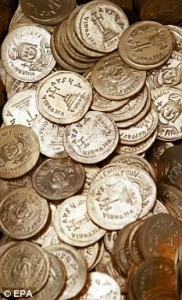 Matthew asks if Justinian unwittingly aided the spread of Islam by exhausting the resources of the empire with his conquest of Italy.
Matthew asks if Justinian unwittingly aided the spread of Islam by exhausting the resources of the empire with his conquest of Italy.
Byzantium was certainly weaker at Justinian’s death than it had been at the start of his reign, but that was not entirely his fault. Invasions are expensive, but Justinian had good reason to think that on balance the empire would be enriched with the addition of Italy. After all the capture of North Africa was lucrative enough to pay for itself within a few years, and it soon became the wealthiest province of the empire.
Italy turned out to be a different proposition- mostly because the emperor couldn’t bring himself to trust Belisarius or fund him appropriately. This vacillation extended the length of the war but it wasn’t what doomed his conquests- given enough time Italy almost certainly would have become a productive imperial possession. What destroyed the Justinianic renaissance was the plague which hit in 541 and killed a quarter of the Mediterranean population. The empire was left reeling with longer boarders, fewer soldiers to patrol them, and fewer taxpayers to pay for it all.
Justinian was forced to depend on his shrinking gold reserves to defend the empire- reducing the ‘bread and circuses’ to buy off the barbarians on every side. His successor Justin II didn’t understand the political realities of the weakened state and slammed on the spending brakes- causing the collapse of the careful alliances Justinian had built up and triggering waves of invasion. The disasters unhinged his mind and he spent the rest of his reign being wheeled through the palace in a golden wagon biting anyone who was foolish enough to come within range. He recovered enough to appoint Tiberius II as successor and (given the circumstances) surprisingly offered him the following bit of wisdom: ‘consult the experience rather than the example of your predecessor.’
Tiberius was more than happy to abandon any hint of austerity. In a bid to be popular he managed to blow through 29,000 pounds of gold in four years, tactfully exiting the stage just in time to leave his successor with an empty treasury and several wars brewing. There was little the new emperor Maurice could do other than to raise taxes and divert everything to the army. He managed to settle most of the wars but his cost cutting made him so unpopular that he was easily overthrown by a soldier named Phocas who promised circuses and free food for everyone. Of course there was no money to do that so he concentrated on killing everyone who looked at him sideways, using his free time to start a war with Persia- the one enemy that had miraculously been at peace with the empire. Phocas was thankfully replaced by Heraclius and the new emperor managed to claw his way to victory against Persia after 17 years of a bruising war.
It was at this point with the empire exhausted, demoralized, religiously divided, and impoverished, that the first Muslim army arrived.
Persia and Byzantium were like prize fighters who had knocked each other out. Just how fatigued they were can be seen by the speed with which they collapsed. Within four years the last Persian Shah was dead and his kingdom conquered. Byzantine Jerusalem barely resisted, Alexandria voluntarily opened its gates, and North Africa put up only a sporadic resistance.
So how much is Justinian to blame? Certainly some- the conquests of Italy, North Africa, and parts of Spain were a tremendous short-term drain of resources. But even if he hadn’t gone west the plague would still have decimated Byzantium. At his death the empire was stretched, but with capable leaders it could have been preserved. Instead he was followed by the foolish (and insane) Justin II, the profligate Tiberius II, and the bloodthirsty Phocas. If Heraclius had followed Maurice instead of Phocas, Byzantium and Persia would have been infinitely stronger. The armies of Islam would have had to contend with the powerful buffer of Persia and if they had broken through they would have met Heraclius’ able grandson Constans II- who had the makings of a brilliant general.
Islam would have been contained within the Arabian peninsula, North Africa may have resembled Western Europe, and the world would be a much different place. As it is Constans II was killed in his bath, Persia was submerged under a Muslim tide, and within half a century the Arabs were in Europe and poised to attack Constantinople by both land and sea.
 Chris asks if the Roman Senate moved with the capital to Constantinople.
Chris asks if the Roman Senate moved with the capital to Constantinople.







